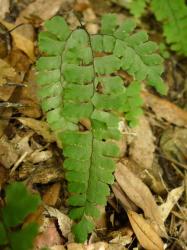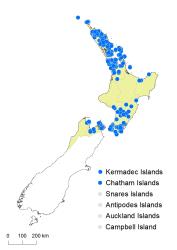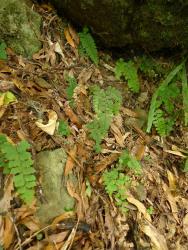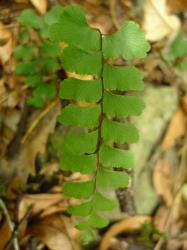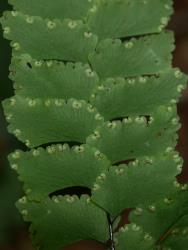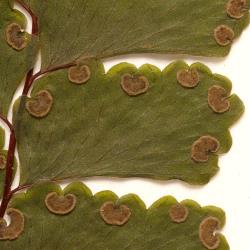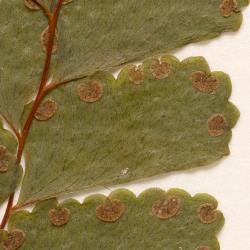- = Adiantum setulosum J.Sm., Companion Bot. Mag. New Ser. 2: 22 (1846)
- = Adiantum polymorphum Colenso, Trans. & Proc. New Zealand Inst. 20: 215 (1888) nom. illeg., non Adiantum polymorphum Poir. 1810
- ≡ Adiantum diaphanum var. polymorphum (Colenso) Cheeseman, Man. New Zealand Fl. 961 (1906) nom. illeg.
- = Adiantum tuberosum Colenso, Trans. & Proc. New Zealand Inst. 20: 217 (1888)
Rhizomes erect, bearing scales; rootlets often bearing small tubers; stolons absent. Rhizome scales acicular, 0.5–1.5 mm long, 0.1–0.2 mm wide, red-brown, concolorous. Fronds 50–390 mm long. Stipes 20–250 mm long, dark brown, polished, glabrous except for scattered scales proximally. Rachises dark brown, sulcate, polished, glabrous. Laminae either 1-pinnate, narrowly triangular, 20–140 mm long, 10–28 mm wide; or 2-pinnate, ovate or broadly ovate, 35–205 mm long, 20–240 mm wide; rarely the basal basiscopic secondary pinna greatly expanded, up to 90 mm long, divided into tertiary pinnae; dark green on both surfaces, herbaceous, either glabrous or bearing sparse to abundant stiff dark hairs adaxially and abaxially. 4–25 pairs of undivided primary pinnae below pinnatifid apex, oblong, tending to curve basiscopically, 6–20 mm long, 3–11 mm wide, apices obtuse or truncate, acroscopic margins lobed, basiscopic margins entire, bases stalked, with stalks attached in one corner. Divided primary pinnae in 1 or rarely 2 pairs, costae glabrous, narrowly ovate or narrowly elliptic, 10–160 mm long, 14–26 mm wide, apices acute, bases stalked. Longest secondary pinnae oblong, 4–15 mm long, 4–7 mm wide, apices obtuse, margins lobed, bases stalked, with stalks attached in one corner. Reflexed lamina flaps reniform, hairy or glabrous.
Adiantum diaphanum is the smallest of the maidenhair ferns in New Zealand. The fronds are either 1-pinnate throughout, or have one, or rarely two, pairs of proximal pinnae that are divided into secondary pinnae. It is distinguished from other species of Adiantum by the presence of tubers on the roots, its oblong ultimate lamina segments with the stalk attached in one corner, its glabrous rachises, and by the green abaxial lamina surface. The species is dimorphic, the abaxial lamina surfaces and “indusia” being either hairy or glabrous. Sometimes the lamina surfaces and “indusia” are either both hairy or both glabrous, but forms are also found with hairy “indusia” and glabrous or very sparsely hairy laminae. When present, the hairy “indusia” distinguish it from all other species except A. hispidulum. That species is distinguished by its helicoid branching, more divided laminae, and hairs that are often more than one cell long. In A. diaphanum the hairs are single-celled, very dark, and with no clearly visible lumen. Plants of A. diaphanum with glabrous laminae and “indusia” can be confused with small plants of A. cunninghamii, but that species always lacks the small tubers on the rootlets that are present in A. diaphanum.
North Island: Northland, Auckland, Volcanic Plateau, Gisborne, Taranaki, Southern North Island.
South Island: Western Nelson, Sounds-Nelson.
Kermadec Islands, Three Kings Islands, Chatham Islands.
Altitudinal range: 5–275 m.
Adiantum diaphanum occurs on the Kermadec and Three Kings Islands, and in lowland areas of the North Island from Te Paki to Wellington. However, it is absent from large parts of Taranaki, the central North Island and Gisborne. It occurs from near sea level, reaching 275 m in the Tutamoe Range, Northland, and near Tikokino, Hawke’s Bay. In the South Island it is confined to lowland areas on the north coast from the Marlborough Sounds to north-west Nelson.
Also Japan, southern China, Taiwan, Vietnam, Malesia, Australia (Queensland, New South Wales, Victoria), Norfolk Island, Solomon Islands, Vanuatu, New Caledonia, Fiji, Samoa and Tonga.
Adiantum diaphanum grows on the ground under podocarp and broadleaved forest, and under kānuka. It occurs on streambanks, river terraces, clay banks, under overhangs, wet rocks, track sides, and swamp margins in shaded sites.
n = 116 (Brownlie 1961).
Adiantum diaphanum was misidentified by some early Flora writers as A. affine Willd. (e.g., Hooker 1864), a species now known to be A. capillus-veneris.
Brownsey et al. (2019) found that, among collections held at WELT, 57% had hairs on the abaxial lamina surfaces and 43% were glabrous or nearly so. Glabrous and hairy plants were sometimes found in the same population. In his original description of A. diaphanum, Blume (1828) noted that the pinnae were glabrous. Price (1990) further noted that “all plants from Java, the source of Blume’s type of A. diaphanum, have glabrous indusia”, whereas plants from the Philippines had setulose indusia and hairy pinnae. He suggested that the hairy plants corresponded to A. setulosum, described by Smith (1846) from Norfolk Island. However, Bostock (1992) rejected this conclusion. He noted that all 16 separate plants on three type sheets of A. diaphanum at L had at least some hairs on the laminae and “indusia”. He noted that there was “no justification whatsoever for using the name A. diaphanum Blume solely for plants with glabrous soral flaps”. He included Adiantum setulosum J.Sm. in the synonymy of A. diaphanum, a decision also followed here.
The hairy and glabrous plants are treated as dimorphic character states within A. diaphanum. Cheeseman (1906) interpreted the typical state of A. diaphanum as having hairy pinnae, and recognised var. polymorphum, based on Colenso’s A. polymorphum, for the glabrous state. In any case, A. polymorphum Colenso is illegitimate, being a later homonym of A. polymorphum Poir. (1810). Further investigation is required to determine whether there is any genetic variation that supports taxonomic recognition of different forms of A. diaphanum throughout its extensive geographical range.
Bostock (1992, 1998) noted that plants of A. diaphanum in Australia are not only tuberous but also proliferous, a feature recorded by Birkenhead (1886), enabling them to form small colonies. Although tubers are common in New Zealand plants, proliferation is unknown in herbarium specimens of wild plants and has only been observed in cultivated plants (http://www.nzplants.auckland.ac.nz/en/about/ferns/native-ferns/pteridaceae-maidenhair-annual-rock-brake-ferns/adiantum-diaphanum.html).



